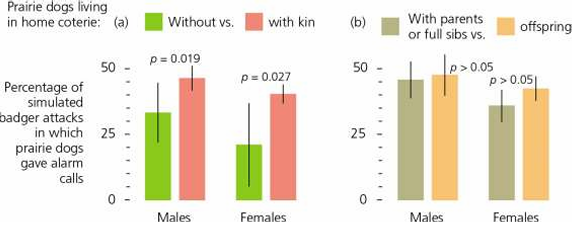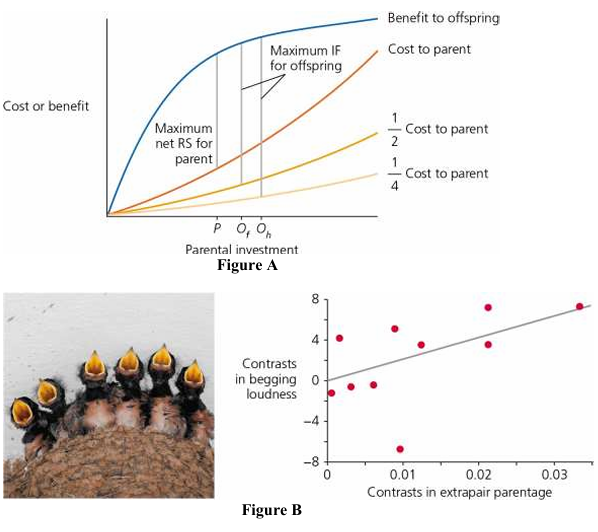PofE: Chapter 12
1/24
Earn XP
Description and Tags
The Evolution of Social Behaviour
Name | Mastery | Learn | Test | Matching | Spaced |
|---|
No study sessions yet.
25 Terms
Social interaction between animals where one individual imposes a penalty on another, and in so doing suffers a loss, is termed ________.
spite
Social interaction between animals that benefits both the actor and the recipient is known as ________.
mutual benefit
Social behavior between animals where the actor benefits at the expense of the recipient is called ________.
selfishness
When one animal makes a sacrifice to support or benefit another, we call this ________.
altruism
One of the keys to understanding altruistic behavior is that ________.
other members of the population will share alleles with the "actor"
The form of natural selection that leads to an increase in the frequency of alleles which promote the fitness of genetic relatives is called ________.
kin selection
A measure of the reproductive fitness of an individual without the help of others is known as ________.
direct fitness
A measure of the reproductive fitness of genetic relatives resulting from the actions of an individual is called ________.
indirect fitness

The accompanying figure shows that the rate of alarm calls made by black-tailed prairie dogs is dependent on a perceived threat by a predator. This behavior most closely approximates that predicted by ________.
altruism

The accompanying figure shows that the rate of alarm calls made by black-tailed prairie dogs is dependent on a perceived threat by a predator. This behavior affects ________.
both the direct and indirect fitness of the caller
The success of altruistic behavior hinges on the ability to distinguish kin from unrelated individuals. Hamilton proposed that an allele that produces a distinctive trait (i.e., the greenbeard effect), along with altruistic behavior directed at the bearers of this trait, could drive such an altruistic allele to high frequencies in a population. This scenario has been discovered and studied in ________.
slime molds
Multilevel selection/cooperation has been documented in ________.
bacteria, plants, humans
One would expect that conflicts between parents and offspring over parental investment would be the most pronounced in ________.
birds

The analysis of parent—offspring conflict in birds has generated some interesting observations. For example, researchers hypothesized that chicks should beg to be fed by their parents more loudly when their nestmates are less closely related. (See Figure A, where Of = optimal parental investment where the lost siblings are full sibs, and Oh for an offspring whose lost siblings are half sibs.) Do the data collected bear this out (Figure B)?
Yes, species that evolve extra-pair parentage also tend to evolve louder begging chicks.
Which hypothesis has been proposed to explain the evolution of eusociality?
the haplodiploidy hypothesis, the Monogamy hypothesis, the ecology/life history hypothesis
Social behavior in which both the "actor" and the "recipient" benefit is known as ________.
mutualism/mutual benefit
Social behavior in which the "actor" makes a sacrifice for the benefit of the "recipient" is called ________.
altruism
Social behavior in which the "actor" benefits at the expense of the "recipient" is termed ________.
selfishness
Social behavior in which a penalty is imposed on the "recipient," while the "actor" also suffers a loss, is called ________.
spite
Hamilton's Rule is a simple expression that specifies the conditions under which altruism will increase in frequency. What is this expression?
Br - C > 0, where B = benefit to the recipient, r = a measure of the genetic similarity of the individuals, and C = cost to the actor.
The sum total of an individual's direct and indirect fitness is known as ________.
inclusive fitness
The existence of a hypothetical allele that confers a distinctive, recognizable trait, along with altruistic behavior toward others with this trait, was coined the ________ [two words] by Richard Dawkins.
greenbeard effect
All cases of altruism (along with some cases of mutual benefit) in which we find behaviors that are selected for because they are beneficial to the recipient are collectively known as ________.
cooperation
The exchange of favors between genetically unrelated individuals, to the benefit of both, is termed ________.
reciprocity
The descriptive term ________ was coined to refer to animals that have overlapping adult generations in which nonreproductive individuals cooperate to care for young.
eusociality